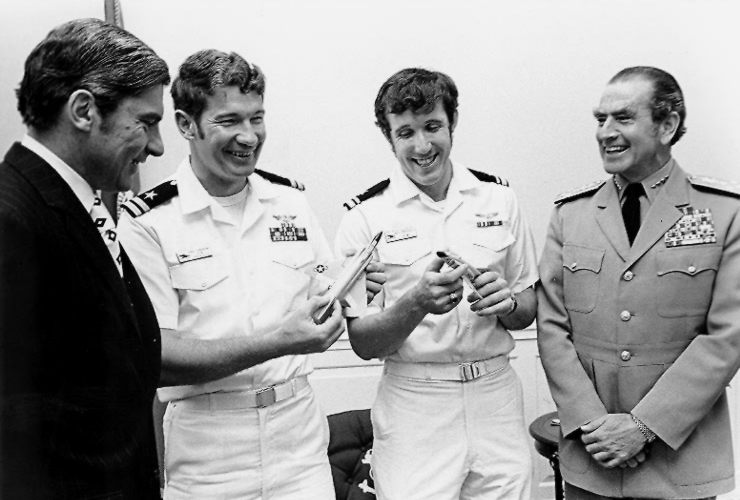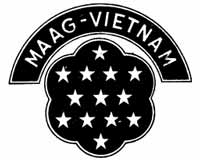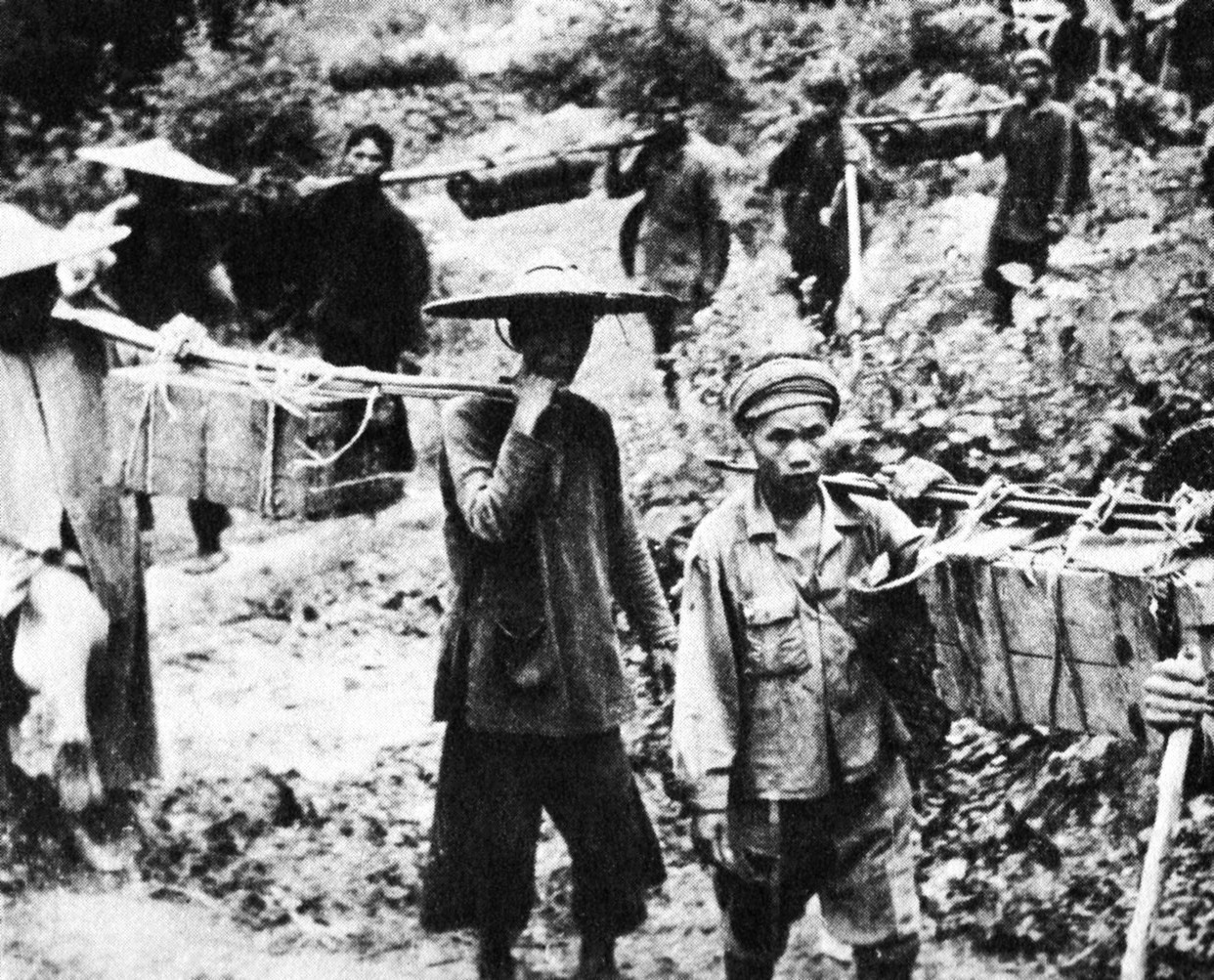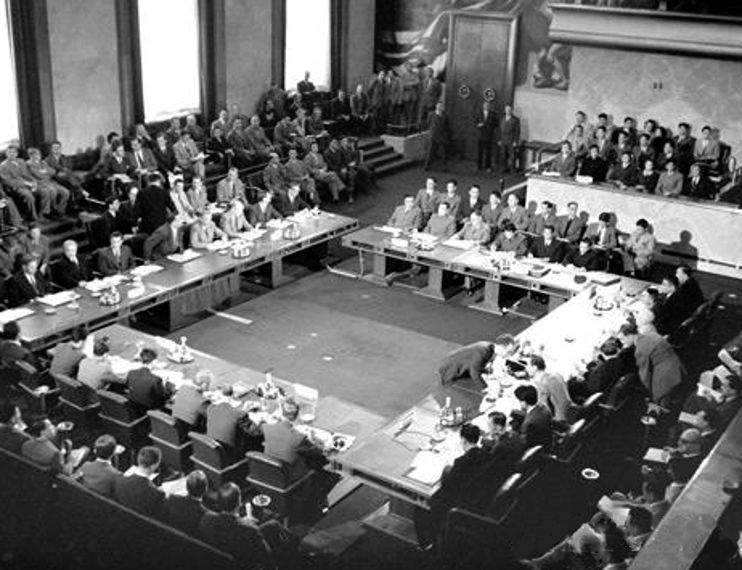|
Naval Forces Vietnam
The U.S. Naval Forces, Vietnam was a command of the United States Navy, active during the Vietnam War, from 1 April 1966 to 29 March 1973.Marolda (2002), p 386 COMNAVFORV also commanded the Naval Advisory Group and the Seabees of the 3rd Naval Construction Brigade; the Military Sea Transportation Service Office, Vietnam, which coordinated the enormous sealift to Southeast Asia; the Officer in Charge of Construction, Vietnam (OICC-RVN), who managed in-country construction by civilian contractors; the Naval Research and Development Unit, Vietnam, which tested new equipment in the field; and Commander Coast Guard Activities, Vietnam, which provided administrative support for Coast Guard Squadron One, Coast Guard Squadron Three and other smaller Coast Guard units in-country. Commanders included Rear Admiral Norvell G. Ward (to 27 April 1967), Rear Admiral Kenneth L. Veth (to 30 September 1968), who was then succeeded by newly promoted Vice Admiral Elmo Zumwalt.Berman, pp 163–17 ... [...More Info...] [...Related Items...] OR: [Wikipedia] [Google] [Baidu] |
Elmo Zumwalt
Elmo Russell "Bud" Zumwalt Jr. (November 29, 1920 – January 2, 2000) was a United States Navy officer and the youngest person to serve as Chief of Naval Operations. As an Admiral (United States), admiral and later the 19th Chief of Naval Operations, Zumwalt played a major role in United States military history, especially during the Vietnam War. A decorated war veteran, Zumwalt reformed United States Navy personnel policies in an effort to improve enlisted life and ease racial tensions. After he retired from a 32-year navy career, he launched an 1976 United States Senate election in Virginia, unsuccessful campaign for the United States Senate. Early life and education Zumwalt was born in San Francisco, California, the son of Elmo Russell Zumwalt, and his wife, Frances Pearl (née Frank) Zumwalt, both country doctors. Frances was raised Jewish, the daughter of Julius and Sarah Frank of Burlington, Vermont. His family moved to Tulare, California, where he grew up. She became estr ... [...More Info...] [...Related Items...] OR: [Wikipedia] [Google] [Baidu] |
Military Assistance Advisory Group
A Military Assistance Advisory Group (MAAG) is a designation for a group of United States military advisors sent to other countries to assist in the training of conventional armed forces and facilitate military aid. Although numerous MAAGs operated around the world throughout the 1940s–1970s, including in Yugoslavia after 1951, and to the Ethiopian Armed Forces, the most famous MAAGs were those active in South Vietnam, Cambodia, Laos, and Thailand, before and during the Vietnam War. Records held by the National Archives and Records Administration detail the activities of numerous assistance advisory groups. Typically, the personnel of MAAGs were considered to be technical staff attached to, and enjoying the privileges of, the US diplomatic mission in a country. "The special status of personnel serving in Military Advisory Assistance Groups (MAAG) results from their position as an integral part of the Embassy of the United States where they perform duty." Although the term is ... [...More Info...] [...Related Items...] OR: [Wikipedia] [Google] [Baidu] |
Viet Cong
The Viet Cong (VC) was an epithet and umbrella term to refer to the communist-driven armed movement and united front organization in South Vietnam. It was formally organized as and led by the National Liberation Front of South Vietnam, and conducted military operations under the name of the Liberation Army of South Vietnam (LASV). The movement fought under the direction of North Vietnam against the South Vietnamese and United States governments during the Vietnam War. The organization had both guerrilla and regular army units, as well as a network of cadres who organized and mobilized peasants in the territory the VC controlled. During the war, communist fighters and some anti-war activists claimed that the VC was an insurgency indigenous to the South that represented the legitimate rights of people in South Vietnam, while the U.S. and South Vietnamese governments portrayed the group as a tool of North Vietnam. It was later conceded by the modern Vietnamese communist lead ... [...More Info...] [...Related Items...] OR: [Wikipedia] [Google] [Baidu] |
Republic Of Vietnam Marine Division
The Republic of Vietnam Marine Division (RVNMD, or '; ) was part of the armed forces of South Vietnam. It was established by Ngo Dinh Diem in 1954 when he was Prime Minister of the State of Vietnam, which became the Republic of Vietnam in 1955. The longest-serving commander was Lieutenant General Le Nguyen Khang. In 1969, the VNMC had a strength of 9,300, 15,000 by 1973, and 20,000 by 1975. The Marine Division traced their origins to the ''Corps des Marines vietnamien'' founded in 1955 as French-trained Commandos Marine divisions recruited and placed under the command of the French Navy but officially incorporated in 1960. From 1970 onwards, the South Vietnamese Marines and Airborne Division grew significantly, supplanting the independent, Central Highlands based Vietnamese Rangers as the most popular elite units for volunteers. Along with the Airborne, the Marine Division formed the General Reserve with the strategic transformation under Vietnamization, with elite and highly ... [...More Info...] [...Related Items...] OR: [Wikipedia] [Google] [Baidu] |
Republic Of Vietnam Navy
The Republic of Vietnam Navy (RVNN; - ''HQVNCH''; was the naval branch of the South Vietnamese military, the official armed forces of the former Republic of Vietnam (or South Vietnam) from 1955 to 1975. The early fleet consisted of boats from France; after 1955, and the transfer of the armed forces to Vietnamese control, the fleet was supplied from the United States. With American assistance, in 1972 the RVNN became the largest Southeast Asian navy and, by some estimates, the fourth largest navy in the world, just behind the Soviet Union, the United States and the People's Republic of China, with 42,000 personnel, 672 amphibious ships and craft, 20 mine warfare vessels, 450 patrol craft, 56 service craft, and 242 junks. Other sources state that RVNN was the ninth largest navy in the world. The Republic of Vietnam Navy was responsible for the protection of the country's national waters, islands, and interests of its maritime economy, as well as for the co-ordination of mariti ... [...More Info...] [...Related Items...] OR: [Wikipedia] [Google] [Baidu] |
Task Force 90 (United States)
Task Force 90 was a United States Navy task force. In 1945 it was Aircraft, North Pacific Force, under Major General D. Johnson USA, part of North Pacific Force under Vice Admiral Frank Fletcher. In the Korean War it controlled the amphibious forces in theatre. It reported directly to Commander Naval Forces Far East. Its most high-profile operation was the Incheon amphibious assault, Operation Chromite. It was later active during Operation Passage to Freedom Operation Passage to Freedom was a term used by the United States Navy to describe the propaganda effort and the assistance in transporting 310,000 Vietnamese civilians, soldiers and non-Vietnamese members of the French Army from communist No ... after the Geneva Accords of 1955. References United States Navy task forces United States Navy units and formations in the Korean War {{USN-stub ... [...More Info...] [...Related Items...] OR: [Wikipedia] [Google] [Baidu] |
Military Sea Transport Service
The Military Sealift Command (MSC) is an organization that controls the replenishment and military transport ships of the United States Navy. Military Sealift Command has the responsibility for providing sealift and ocean transportation for all US military services as well as for other government agencies. It first came into existence on 9 July 1949 when the Military Sea Transportation Service (MSTS) became solely responsible for the Department of Defense's ocean transport needs. The MSTS was renamed the Military Sealift Command in 1970. Military Sealift Command ships are made up of a core fleet of ships owned by the United States Navy and others under long-term-charter augmented by short-term or voyage-chartered ships. * During a time charter MSC takes control of a merchant ship and operates it for the chartered amount of time. During this time the ship is crewed by civilian mariners and MSC pays for all expenses. Time chartered ships are not subject to inspections from foreign ... [...More Info...] [...Related Items...] OR: [Wikipedia] [Google] [Baidu] |
Operation Passage To Freedom
Operation Passage to Freedom was a term used by the United States Navy to describe the propaganda effort and the assistance in transporting 310,000 Vietnamese civilians, soldiers and non-Vietnamese members of the French Army from communist North Vietnam (the Democratic Republic of Vietnam) to non-communist South Vietnam (the State of Vietnam, later to become the Republic of Vietnam) between the years 1954 and 1955. The French and other countries may have transported a further 500,000. In the wake of the French defeat at the Battle of Dien Bien Phu, the Geneva Accords of 1954 decided the fate of French Indochina after eight years of war between the French Union forces and the Viet Minh, which fought for Vietnamese independence under communist rule. The accords resulted in the partition of Vietnam at the 17th parallel north, with Ho Chi Minh's communist Viet Minh in control of the north and the French-backed State of Vietnam in the south. The agreements allowed a 300- ... [...More Info...] [...Related Items...] OR: [Wikipedia] [Google] [Baidu] |
17th Parallel North
Following are circles of latitude between the 15th parallel north and the 20th parallel north: 16th parallel north The 16th parallel north is a circle of latitude that is 16 degrees north of the Earth's equatorial plane. It crosses Africa, Asia, the Indian Ocean, the Pacific Ocean, Central America, the Caribbean, and the Atlantic Ocean. At this latitude the sun is visible for 13 hours, 5 minutes during the summer solstice and 11 hours, 11 minutes during the winter solstice. As a dividing line After World War II, the parallel divided Vietnam into Chinese military administration in the north and the British in the south (See Timeline of World War II (1945) and War in Vietnam (1945-1946)). In the Chadian–Libyan conflict, from 1984 the parallel, known as the "Red Line", delineated areas controlled by opposing combatants. Previously the Red Line had been the 15th parallel north. (See also Operation Manta.) Around the world Starting at the Prime Meridian and heading eastw ... [...More Info...] [...Related Items...] OR: [Wikipedia] [Google] [Baidu] |
Geneva Agreements
The Geneva Conference was intended to settle outstanding issues resulting from the Korean War and the First Indochina War and involved several nations. It took place in Geneva, Switzerland, from 26 April to 20 July 1954. The part of the conference on the Korean question ended without adopting any declarations or proposals and so is generally considered less relevant. On the other hand, the Geneva Accords that dealt with the dismantling of French Indochina proved to have long-lasting repercussions. The crumbling of the French colonial empire in Southeast Asia led to the formation of the states of the Democratic Republic of Vietnam (North Vietnam), the State of Vietnam (precursor of the future Republic of Vietnam, or South Vietnam), the Kingdom of Cambodia, and the Kingdom of Laos. Three agreements about French Indochina, covering Cambodia, Laos, and Vietnam, were signed on 21 July 1954 and took effect two days later. Diplomats from South Korea, North Korea, the People's Republ ... [...More Info...] [...Related Items...] OR: [Wikipedia] [Google] [Baidu] |
Battle Of Dien Bien Phu
The Battle of Điện Biên Phủ was a climactic confrontation of the First Indochina War that took place between 13 March and 7 May 1954. It was fought between the forces of the French Union and Viet Minh. The French began an operation to insert, and support, their soldiers at Điện Biên Phủ, deep in the autonomous Tai Federation in northwest Tonkin. The operation's purpose was to cut off enemy supply lines into the neighboring Kingdom of Laos (a French ally) and draw the Viet Minh into a major confrontation in order to cripple them. The French based their forces in an isolated but well-fortified camp that would be resupplied by air, a strategy adopted based on the belief that the Viet Minh had no anti-aircraft capability. The communist Viet Minh, however, under General Võ Nguyên Giáp, surrounded and besieged the French. They brought in vast amounts of heavy artillery (including anti-aircraft guns) and managed to move these bulky weapons through difficult terrain ... [...More Info...] [...Related Items...] OR: [Wikipedia] [Google] [Baidu] |
Haiphong
Haiphong or Hai Phong (, ) is the third-largest city in Vietnam and is the principal port city of the Red River Delta. The municipality has an area of , consisting of 8 urban districts, 6 rural districts and 1 municipal city (sub-city). Two of the rural districts cover islands in the South China Sea: Bạch Long Vĩ and Cát Hải. It has a population of 2,130,898 in 2023. The city's economy has strength in manufacturing, as evidenced by large industrial parks and numerous smaller traditional handicraft villages. Historically, Haiphong was the first place in Vietnam and Mainland Southeast Asia to get electricity. In the imperial era of Đại Việt, the Bạch Đằng River in Haiphong was a place of many legendary victories, led by now-legendary commanders Ngô Quyền and Trần Hưng Đạo. In the 16th century, Mạc dynasty promoted the coastal settlement as a secondary capital, growing to become an important port town of Đàng Ngoài. After the French conquest of ... [...More Info...] [...Related Items...] OR: [Wikipedia] [Google] [Baidu] |








